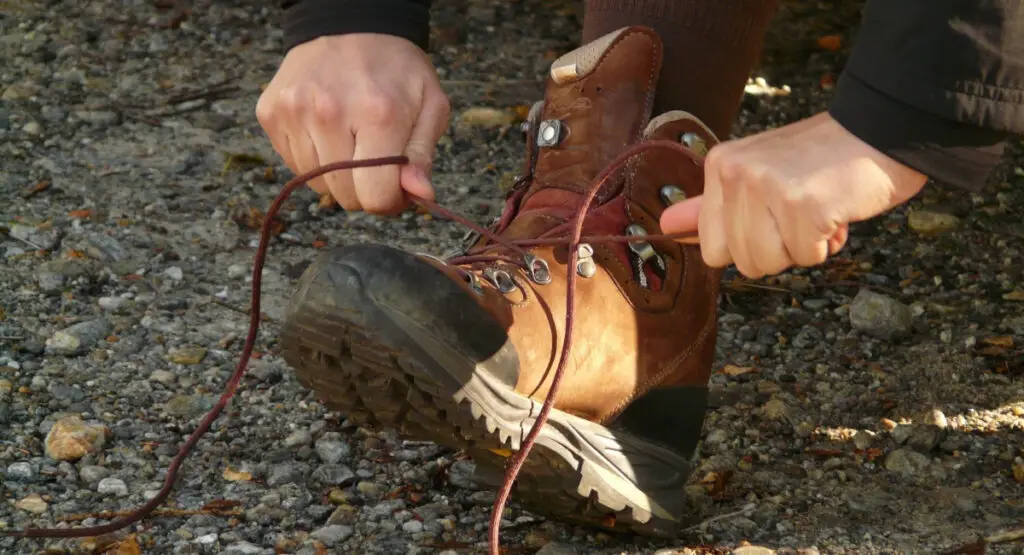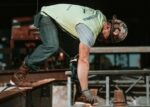Acing the lacing game of the welding boots may need some techniques but once you are familiar with them, you will effortlessly ace them.

There are standard lacing techniques while there are advanced lacing techniques and, in this article, we have brought you everything you need to know about lacing.
Lacing Techniques for your Welding Boots
You can stick to the following methods to lace your welding boots:
1. The 2-1-3 lacing mechanism
The feet in the 2-1-3 mechanism will be more comfortable to feet than in any other lacing mechanism as there will be no more unnecessary pinching on the feet.
The major drawback of the acing mechanism is that the first few attempts can be the type of drag because the first few attempts can be a bit complicated.
Lacing mechanism:
Discover the three eyelets that go around your ankle. You need to normally lace your boots until and unless you get to the bottom of one of all the three eyelets.
After that, follow up with a regular criss-cross pattern. Just make sure that you don’t thread the lace via each eyelet in order.
See also: Boot Lace Length Guide
2. Army lacing technique
First thing first, start by threading your laces from inside and outside. Now, you need to thread the laces in an upward direction via the follow-up set of eyelets. You need to make sure that while you are doing this, you are doing it without crossing them.
After this, all you need is to thread the laces via the eyelets on both of the opposite sides. In the next step, you need to do the same but you need to make sure that you are doing it vertically. This needs to be continued until and unless you reach the top and after that, you can tie your boots like you always do.
When all the above-mentioned statistics are equally implemented, you will be provided with a result where all the verticals are on the outside, on the other hand, all the crossovers are on the inside.
3. The heel lock lacing method
Here, you need to involve only two eyelets on your boots. As it demands lace work boots, the first thing is that from the bottom, you need to lace them up until and unless you reach the top.
After you are done reaching the top, you need to take every lace vertically into the last of the eyelet. Now take every lace and bring it under the vertical line that you last made on the opposite side.
You need to bring it closer to the inside section of your boot. The final step of this system is that you need to tie a regular bow and you are done with that, you are already.
4. Rope ladder
You need to start by lacing through the bottom eyelet. You need to make sure that you do this from the inside out. After this, you need to hold the laces vertically so that you take an equal length on either side.
Now bring the two laces across in horizontal position at the same time and carefully twist them each time around each other.
After this, you need to pull the taut, Now move from the inside to outside of the boot and while doing so you need to lace the shoestring via the following eyelet. You need to repeat the process until and unless you reach the ankle portion of our boot.
5. Italian corkscrew
You need to start by stringing the shoelace via the bottom set of eyelets from the outside in. Through this, you will get the lace on the inside of your boot now.
Now you need to take the shorter end of the lace and after that stringing the lace via the same eyelet on the same side. It needs to be done from inside to outside to get the right lacing system.
Now take the longer half of the shoelace and use its string via the following horizontal eyelet. This has to be done in such a way that the shorter end of the string should be underneath the cross while you are doing this.
After that continue with the long end of the lace by bringing it to the following parallel eyelet and then stringing it through. You need to repeat the steps but you need to do this with the longer end of the shoelace until and unless you reach near the ankle.
Finally, you need to have your shoestring inside your boot and it should be in the final eyelet. The following step for you to do is to string it through the following horizontal eyelet.
Since the shorter end of the lace is already there, all you need to do is bring the lace through the following vertical eyelet.
You need to do this by moving from inside to outside. Now you will discover that either end of the shoelace is somewhat of the same length. You need to finish the mechanism by tying your boots.
6. Over-under and friction-free
With an even number of eyelets, you need to place the bottom-most eyelet and you need to do this from outside. But if you have an odd number of eyelets, you need to lace the bottom.
As such, you need to do this in the inside out manner. But firstly, you need to make sure of the number of eyelets which you can by holding the laces vertically.
For, even the number of eyelets, you need to stick to the under-crossing method. So, you need to start by bringing the lace of one side over the tongue. In the case of the opposite eyelet, you need to do this from inside to outside.
After this, you need to bring the lace across in the shape of a diagonal but you need to do this by running from inside to outside via the eyelet.
After you are done with this, you need to do the same with the other side as well. For finishing the lacing, you need to repeat the process twice or thrice.
In case you have an odd number of eyelets, you need to do the process in overtop manner. You need to follow the reverse process of the even number of eyelets.
7. Paratrooper ladder
You need to start the lacing process through the bottom-most eyelets. You need to make sure that you are doing this from the inside out. Now you need to hold the laces in the vertical position so that you get the same amount on each side.
After this you need to insert the laces inside the following eyelet in a vertical manner, After you are done with this, you will find each lace in the inside portion of the boots.
Follow this up by crossing the laces over the tongue and then via the eyelet. In short, all you are doing in this step is that you are running the eyelet through the loop which you have already created.
After this, you need to lace the shoestring via the following vertical eyelet. You need to be very careful about the process that you started at the beginning, that is you need to maintain the order of standard left to right if you have continued with the same sequence and vice versa. The previous procedures are to be repeated to properly lace the boot.
See also: Are composite toe boots good for welding
Problems while Lacing boots and solution
The following are some of the issues that you might face in case you don’t lace your shoes properly. Along with the possible problems, we have brought you the solution to the same as well.
1. High Arches
To deal with these issues, you need to give a shot to the following lacing type:-
-
-
- You need to follow the crisscross method while lacing the first set of eyelets
- In the next step, through the sides, thread the shoelace
- The final step is to tie up the shoe and you need to do this through the next two eyelets or even more if needed
-
This lacing type will help in alleviating the tightness and thus will add the needed comfort
2. Shoes are too tight
For shoes that are too tight, implement the following activities:-
-
-
- Stick to the parallel fashion of lacing without crisscrossing
- In the next step, you need to thread the shoelace in every other eyelet
- Just tie your shoe up normally
-
You will see the laces are evenly distributed that will provide you with all the deserved comfort.
3. Midfoot is very high
If you have the midfoot high issue makes sure to follow the below-mentioned lacing types
-
-
- Crisscross is the type of lacing that you need to start with
- Around the midfoot portion, you need to thread the shoelace. You need to make sure that you do this through the sides
- You need to criss-cross again after the point of discomfort
-
After you are done with it, you will see that the pressure has been minimized to the utmost level.
4. Slipping off the heels issues
With this lacing, your ankle will get the support it needs and it won’t make your shoe feel that it is too tight. You need to follow the below-mentioned steps:-
-
-
- Follow the normal while lacing till the second-to-last hole.
- Without crisscrossing the laces, you need to head straight to the final hole
- In this step, you need to thread the shoelace via the loop onto the other side
- This is the last step where you need to tie your shoe normally
-
This lacing technique will help your ankle be comfortable as the shoe won’t be very tight as a whole.
5. Generally having wide feet
For such concern, you need a lacing style that will provide your foot more comfort and space. Follow the steps to lace your welding boots.
-
-
- Stick to the criss-cross method to lace your shoes
- You need to thread your shoe in a crisscross method in every eyelet
- This is the final step where you need to tie your shoe like you usually do
-
This method will in turn help you in giving your foot the needed space.
Cause of Tight and Loose Fitting of the Laces
You also need to make sure that your laces are not too tight nor too loose as if either of the situations occurs then you might not be able to provide your feet with the level of comfort that they deserve.
In case if you have made your laces too tight then you can endure, chances are that you will encounter the following problem.
-
-
- Besides causing the occasional discomfort, it will cause pain in your feet
- Possibilities are that tight lace will lead to twisting your ankle
- Tying lace too tight will also help you biologically by causing unnecessary excess pressure which will lead to a severe impingement of nerves
- The normal flow of blood circulation might get unbalanced
-
In case if you have made your laces too loose then you usually do, you might come across the following problems.
-
-
- You might get uninviting cramping in your leg region
- Instead of providing you comfort while you do your work, you will get distracted
- With loose lacing, simple walking becomes difficult
-
Conclusion
On the endnote, you should always lace your welding boots according to your convenience and your profession. Besides, the comfortable factor you can also consider variations while lacing your welding boots.
The technique that is involved in lacing these welding boots is unique in every manner so if you want to try out different variations, you can do that too. Hundreds and thousands of lacing techniques are available out there, you can try out various possible variations and see which lacing technique you like in particular.
The above-mentioned lacing techniques are comparatively easy to implement and bring out some razzle-dazzle in the lacing of your welding boots. Now that you have all the information you need, you are all set to lace your welding boots comfortably and head off to work.







